|
Northern Patagonia
The Welcome in Chaitén
I was pushing the bike from the ship in heavy rain when two familiar figures waved at me from the shore. It was a couple whom I had met at the Termas de Palguín ten days before. We had been the only visitors to the spa. They had not stayed long, as the 32-degree temperature in the warm pool was apparently too cold for the lady. Then they had returned to look for some lost sunglasses. They now appeared very hearty and were staying in Termas del Amarillo, less than 30 km from Chaitén. They told me that it was nice there and that I should visit them. But it was raining so heavily that I did not leave Chaitén, but found accommodation with WiFi and had my clothes washed. As the laundry was closed, they washed my clothes free of charge in the hospedaje where I was staying. Clean clothes are the biggest problem on such a trip. Cycling in the hills makes me sweat and on the third day I am already beginning to stink, even to myself. So I took advantage of every opportunity to have my laundry done. There was nothing in Chaitén, two stores and a few empty pubs, all open only in the evening. Otherwise, heavy clouds and rain, rain, rain.
A Repeat Success
It was not raining on the following morning, the clouds were still low, but one could feel it would soon clear up. It remained rather cloudy, right until noon. I cycled along the initial 20-km paved section on a surprisingly good road with a wide verge and minimal traffic. The subsequent dirt road was quite a shock. For another 20 km the road was being repaired, possibly in preparation of a reinforced surface. But at that time there was a 10-cm layer of gravel on which cycling was really ghastly, if one could even call it cycling in such a case. I heard a soft tinkling from the front wheel and knew it was bad. Indeed, the front pannier rack had broken again on the right side, now a little more skillfully than in Bolivia. This one cracked on the head of the cross bar through which a screw goes into the fork. So the right front bag had to be removed. I placed it on my rear rack and fixed the broken strut to prevent it from puncturing the tire while cycling. This really did not suit me. Here I had to carry a lot of food and one bag less would be a problem. I went into the forest, cut off a fresh juicy twig as thick as a thumb, reinforced the pannier rack with it and then attached the bag again. It worked and so I hoped that I would be able to travel with it to the end.
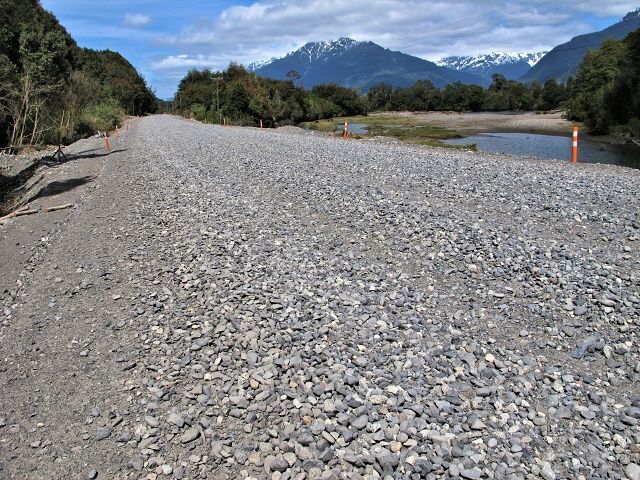
[Near Chaitén] An unfinished road, loose gravel surface – “tailored to a cyclist's needs”

[Near Chaitén] I progressively repaired the broken carrier with a cut branch
Patagonia Me Gusta!
This is what we, Hispanist amateurs, say. And Patagonia is really to my taste, a beautiful landscape with picturesque snow-capped mountains, volcanoes, glaciers, lakes, many rivers and green forests all around. Little civilization, minimal road traffic, only the roads could have been much better. Usually the roads were littered with gravel, bumpy and very corrugated. It was therefore best to cycle in the middle of the road, on the highest part. Sloping edges strewn with gravel are slippery, curves are especially dangerous. Once I fell off the bike, fortunately only just off the edge, nothing dangerous. But even on the local dirt road, there were perfect sections where one could cycle almost as if on a paved surface. The worst was, when I was in the saddle before the Piedra de Gato, where there was a series of hairpin bends and the altitude was increased mainly on the bends. In the steepest parts, I rather pushed the bike due to the gravel and slippery surface. A surprise awaited me when, after a steep downhill seesaw descent, I reached a paved road of the highest quality, neat and tidy, with clean verges and with as little traffic as on the preceding dirt road.
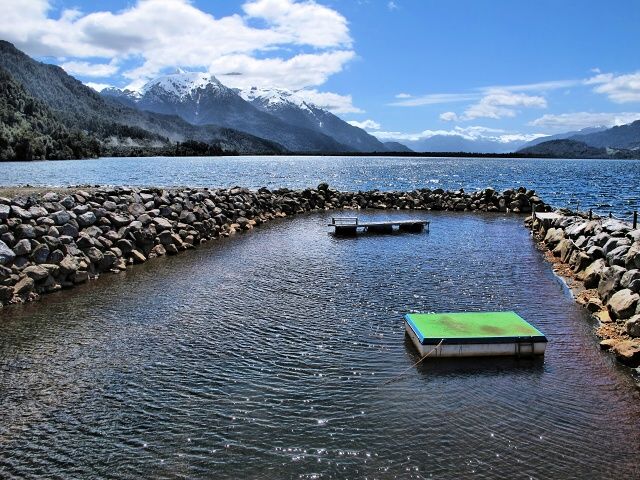
[Yelcho Lake] A pier
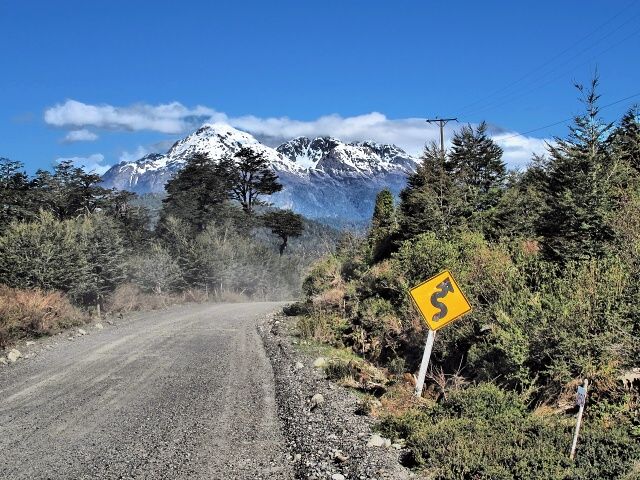
[Near Villa Santa Lucia] The dirt road raised a lot of dust: simply a Chilean quality

[Near Villa Santa Lucia] In such a landscape you can ride like the wind

[Villa Santa Lucia] A church
The weather was unusually favorable. The first three days were almost cloudless and very warm, so I cycled only in shorts and a shirt. It only started to rain on the evening of the fourth day, but nothing dramatic. One could still cycle comfortably in the rain. And what I love – sleeping in a tent in the wilds. Well, there was also no other option. Every day I found a site near a river or lake, so that I could wash and have water for cooking. I had not even realized before that I was such a cleanness fanatic. I always got completely undressed, dived into the ice-cold water and even washed off the dust and sweat from my otherwise inaccessible back with water from a cooking pot. The feeling was interesting – the head does not desire it much, but the body is already looking forward to the sharp rush of blood and the feeling of heat during the first immersion in icy water.
The problem was to find a river or lake in the first place. They all seemed to be on private property there, which was fenced in to keep the animals in the pastures. Of course, it would not have been a problem to crawl under a fence, but that was contrary to my principles. Thus far, I had not resorted to this. Twice I slept in a campsite - the first time at Risopatrón Lake, where there was even running water in the taps at the various tent sites, but no one at the reception to collect any fees. The second time I stayed in San Sebastian camp which was closed due to maintenance, but next to the chain across the road was a convenient entrance for bicycles. So I felt justified at letting myself in, thinking that it had been left open on purpose for cyclists. There were large open sheds with outdoor fireplaces. In one shed I put up my tent on the concrete floor without a ground sheet, as I was under a roof. Again, I appreciated the self-supporting tent structure, I probably would not have been able to hammer pegs into the concrete. Moreover, I dried out the groundsheet, which was still wet inside. The mornings are quite damp there.

[Near La Junta] Waterfalls surrounded by the mountains

[Termas del Ventisquero] Thermal baths in the sea fjords
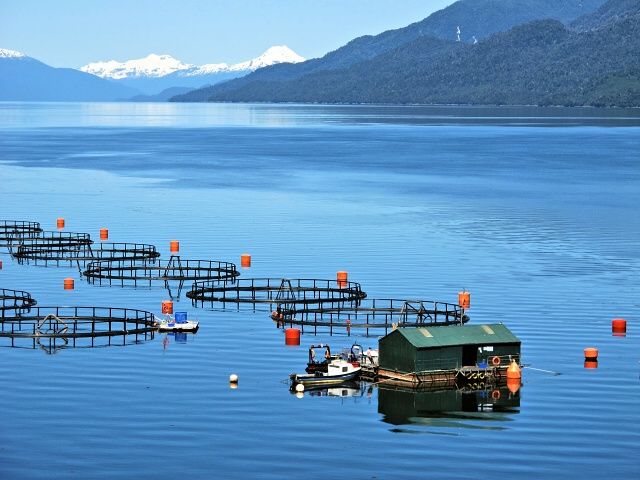
[Near Puyuguapi] Salt-water fish breeding (probably salmon)
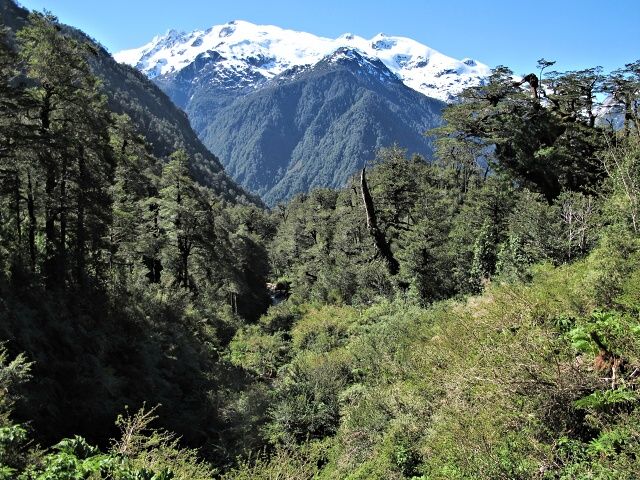
[Near Piedra del Gato] Splendid views compensated for the tiring climb
I am not alone here
The following day, I saw the tracks of two bikes on the road and estimated that they were not more than one day ahead of me and that I would meet them somewhere along the road. Several hours later, I encountered a French couple having lunch by the roadside. Sandra and Rafael had left their home near Lyon for Africa, then sailed to Brazil and were now in Patagonia and planning to go to Ushuaia like me. But they would not be stopping there, but continuing northwards again and would cycle for as long as they enjoyed it. They had built a house, rented it out and used the income to travel. An excellent plan. They were really nice, immediately offering me food and drink. They were cycling in shorter stages than I, about 50 km per day and so they wanted to end the day at La Junta, while I intended to cycle on about another 35 km.

[Near La Junta] Sandra and Rafael set off from Paris via Africa to South America; the end is a long way off
On the following day, I met two young Argentinean men, apparently on their first bike trip, making a fire by the roadside on which to cook their lunch. They also had the same goal, to cycle slightly longer sections than the French, but still shorter distances than me. Maybe, if they sped up, we might meet again on the road. They had sporty figures and enough strength to keep up with me.
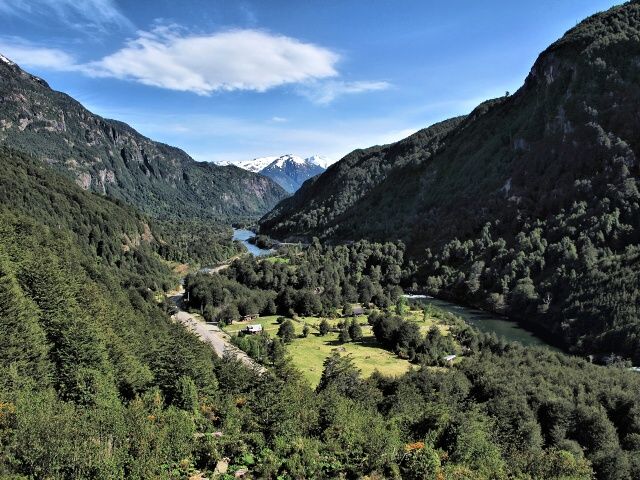
[Near Villa Amengual] Rio Grande valley
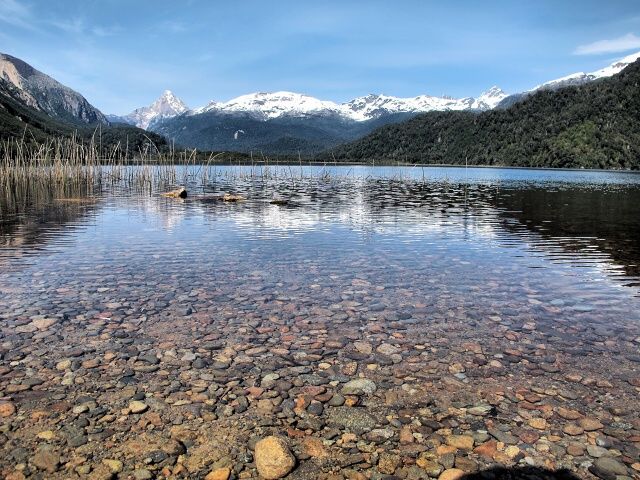
[Lago Las Torres] I collected some drinking water and feasted my eyes on the landscape around me

[Near Villa Maòiguales] Marvellous landscape and excellent road – that´s fantastic!
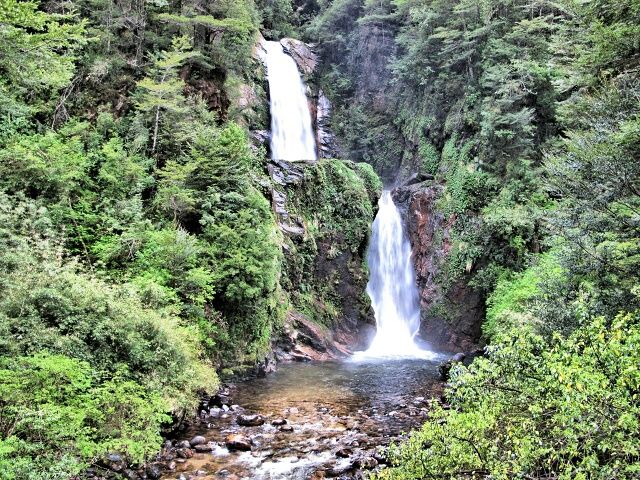
[Virgen de la Cascada] Waterfalls consecrated to Virgin Mary

[Tunel El Farrelón] The rainbow arched over the Rio Simpson Valley
Coyhaique
This is the biggest town in that area. I had a one-day rest, ate in restaurants and stocked up on food supplies. In the only bike store, I finally bought a good quality chain lubricant and in gratitude glued my visiting card to the guestbook to make the sympathetic owner happy. I washed the chain thoroughly with WD, cleaned all the moving parts and greased them with Teflon oil. Then I wiped the bike with a wet cloth, so it looked much better. Other shopping – I finally solved the problem of the infrared data transfer from the cyclocomputer to the computer – I bought a new USB to IrDA (7 USD) and transfers went very smoothly. And, as a precaution, I bought some tightening tapes for future repairs. I also tried to get the details of the sailings from Villa O'Higgins, but the Information office knew even less than the Internet.
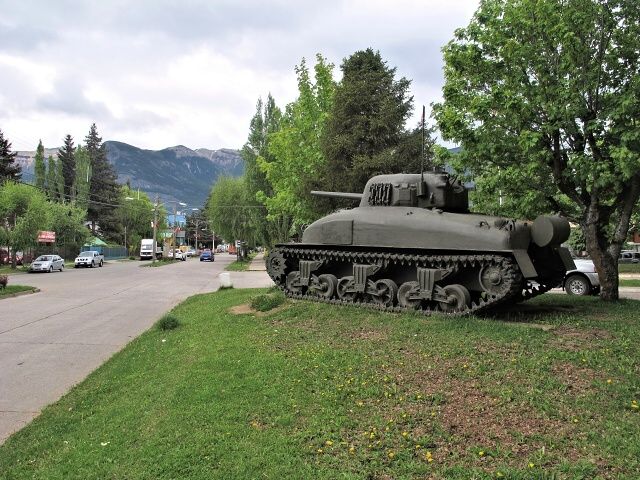
[Coyhaique] The town entrance guarded by a tank at the local military headquarters

[Coyhaique] On All Souls' Day graves are decorated in many countries, but not with such pomp as in Mexico
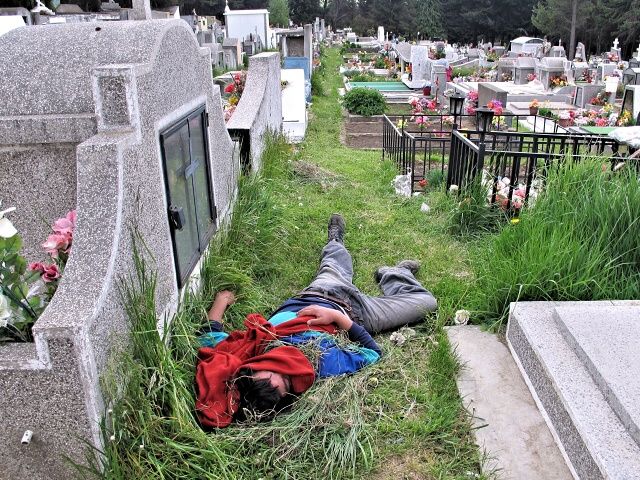
[Coyhaique] They probably forgot to bury this one (because of the hurry or too much work)
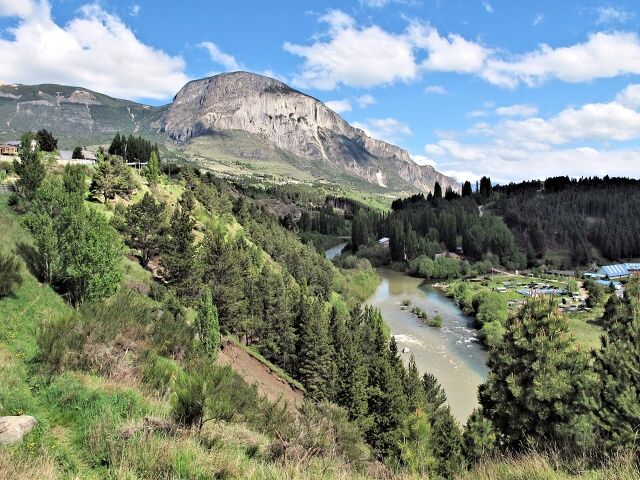
[Coyhaique] Rio Simpson valley
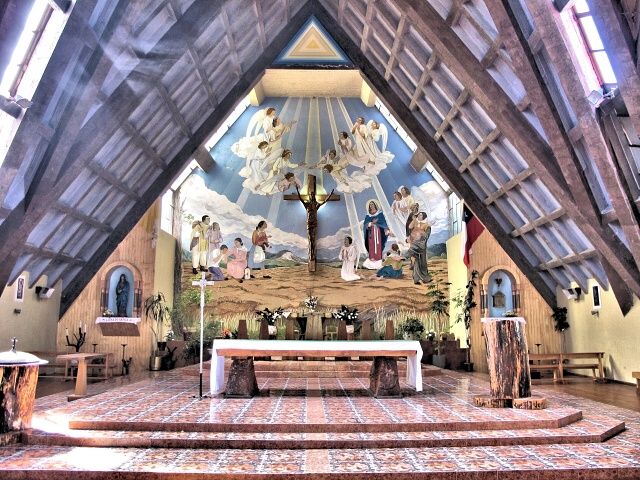
[Coyhaique] The modern Cathedral altar
Farewell to Paved Roads
Almost 100 km of good road lay ahead, where the relatively long and frequent hills were not a problem. Passing through Cerro Castillo National Park was a very refreshing experience, little traffic, deep fragrant forests, almost always at least a stream flowing beside the road, if not a river, even some lakes en route. In Villa Cerro Castillo, I cycled to the campsite, which must be very comfortable in season – a big kitchen, a social room with open fireplace, stoves, fridges, hot-water showers. Unfortunately, none of these were functioning, only a cold-water shower which I was grateful for. The owner lived on the hill above the camp and so he came to charge me and to ask whether he should turn on the electricity. However, I did not need it. The stoves used gas, but there was no gas cylinder anyway, and so electricity would not have been of any use. I cooked on my cooker but did not feel like making a fire in the indoors open fireplace and campfires were not permitted. So I sat reading for a while in the kitchen. Thanks to the Kindle, I always had something to read and often the book was so interesting that it was at the expense of sleep.
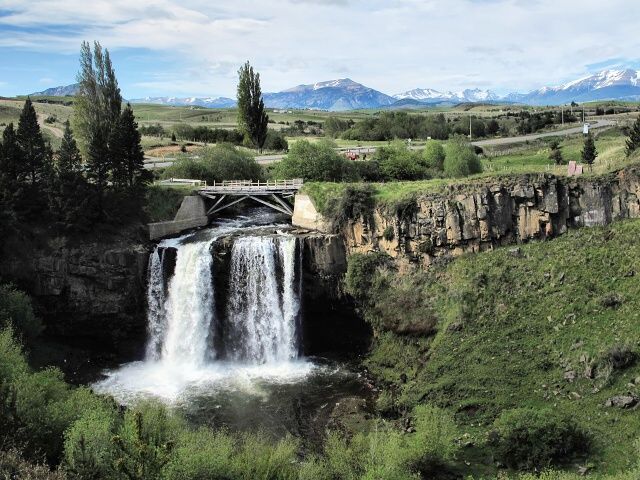
[Rio Polux] A waterfall by the road
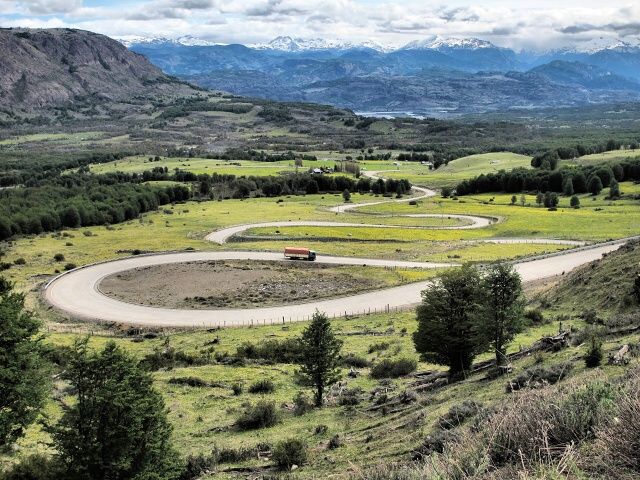
[Near Villa Cerro Castillo] Winding roads on fantastic concrete road, delightful riding - almost track cycling

[Cerro Castillo] The mountain Castillo (2318 metres high) is an icon of the local area; it has an impressive jagged peak
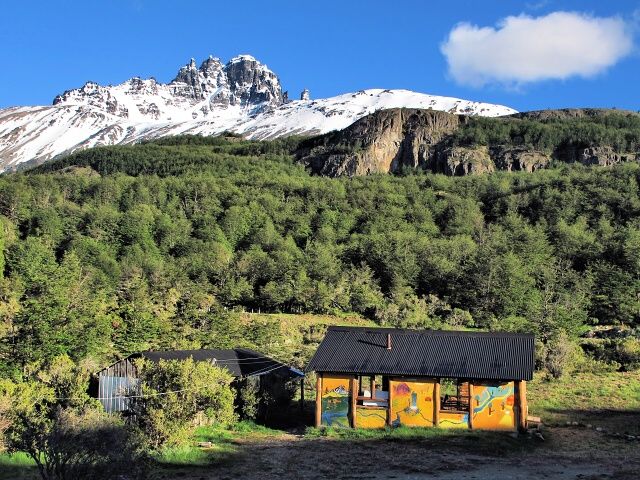
[Villa Cerro Castillo] Camping El Bosque; Cerro Castillo looms high over it
Amazing Landscape
Bumping along on the bad road was compensated for by the spectacular scenery through which I was passing. Bright white snowy peaks towered above the deep river valleys. These extended across the widths, with dead trees (typical of this region) sticking out of the riverbed. The greatest concentration of trunks was in Bosque Muerte, i.e. the Dead Forest. From the valley of the Sopresas River, the road followed the Murta River and the surface in this section was so far the best of the dirt roads I had experienced. The dirt road had track marks on it and was gravel-free. This surface was better than a paved surface for the bike. The route was variable and the ride very pleasant. Rain was on the way, so I stopped beside the Murta River.
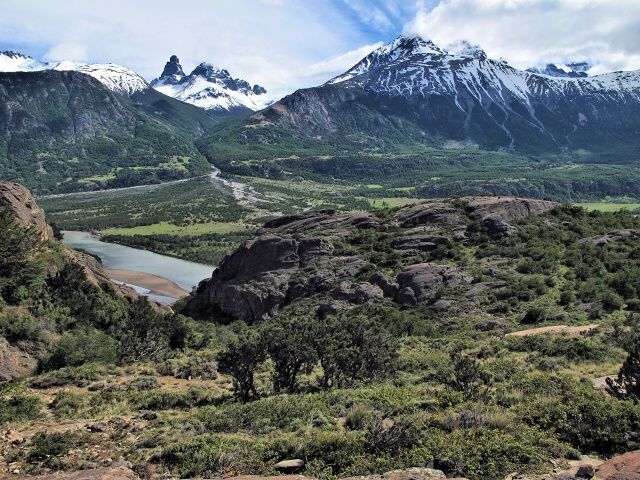
[Near Villa Cerro Castillo] It was often difficult to keep an eye on the broken road when surrounded by such a panorama

[Near Villa Cerro Castillo] A descent towards the river
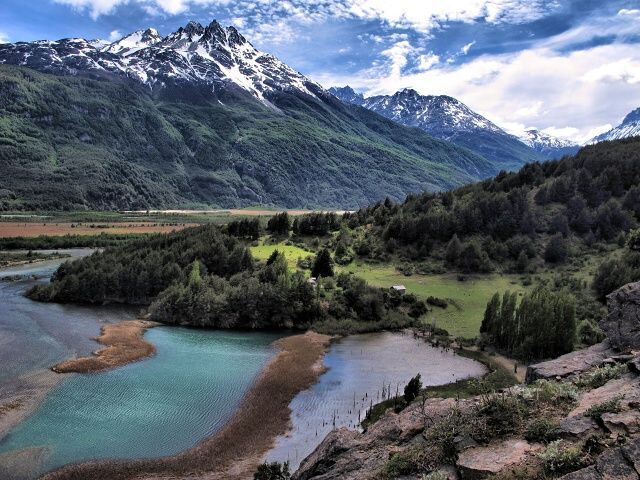
[Near Villa Cerro Castillo] The wide-flowing river
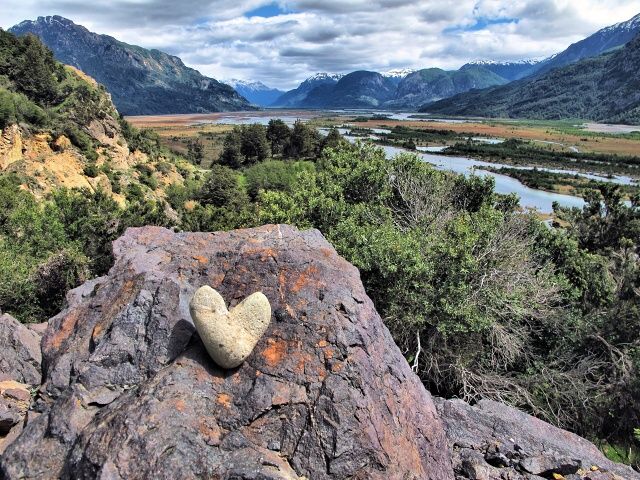
[Near Villa Cerro Castillo] I found a suitable stone and had the idea for a sign: I love Chile
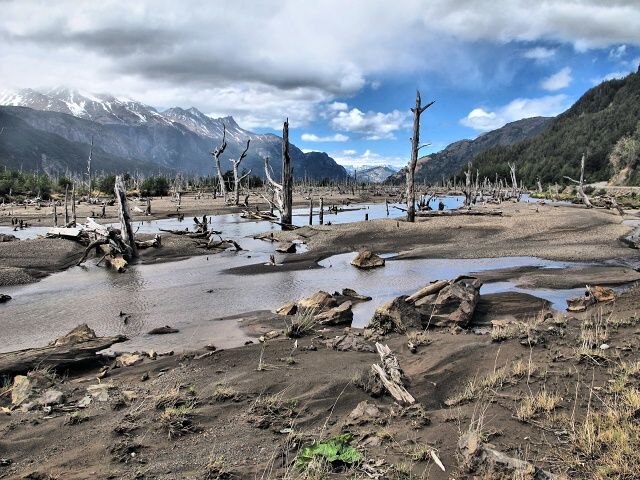
[Near Villa Cerro Castillo] Dead trees in Bosque Muerte
That night it started to rain, and was still raining in the morning, so I lay in the tent and read. I set off before 11 a.m., but, after a while, had to change into my waterproof clothing. At times it seemed as if the rain was over, but just when I started to take off the waterproof clothes, it immediately began to rain again. The old jacket gets drenched in about two hours, but I was saving the new Gore-Tex jacket, I do not know why, for worse conditions. I was wet in any case in the rain, it was hard to tell whether it was due to the clothes or the sweat which was unable to evaporate.

[Near Puerto Murta] Workers did not manage to finish it before the weekend, they left it for the Monday and I had to slide on it on Sunday
An Encore for Great Success
As usual, it began with a strange sound coming from the rear wheel. I did not have to search for long for the defect, it was clear at first glance. The head of the rear pannier rack next to the cartridge was broken. I stopped cycling, as it was clear that my carpentry skills would again be tested. There were no bushes or trees near the road, but fortunately in the distance I saw a bamboo clump, so I repaired it quite well there and was on my way in less than an hour. I had to admit that the rear carrier was entitled to break already, it had lasted for more than 40,000 km, so deserved a rest. But the front pannier rack, being probably a Chinese low-quality product, had cracked after about 2,000 km. The previous carrier, which differed only in its embossed Blackburn company logo, had lasted for more than 15,000 km and had even been bought second-hand in a pub in Broome, Australia.
Sweat to Cochrane
I woke up to a beautiful morning, with the sun shining on my tent. I let everything dry off as I was not in a hurry to get anywhere. Cochrane, the last outpost of civilization on Carretera Austral, as they themselves say, was 90 km away. The first 10 km were easy, almost as if on flat terrain. The lovely views of General Carrera Lake and its deep blue color contributed to my good mood. From time to time, I checked the previous day's repair to the rear pannier rack, but it was holding up well. The road began to dip around Lago Negro and then it was up and down. Even the small hills, almost not visible at first sight, were very steep. The last 30 km to Cochrane was really challenging. I had a problem not only with cycling, but even with pushing the bike up some of the hills. In some sections I even thought that I would not freewheel downhill, but rather walk next to the bike. However, before I had made up my mind, I was already at the bottom of the hill. On one hill, a van stopped and the driver offered me a ride to Cochrane, which I refused with thanks. I still had my morals.
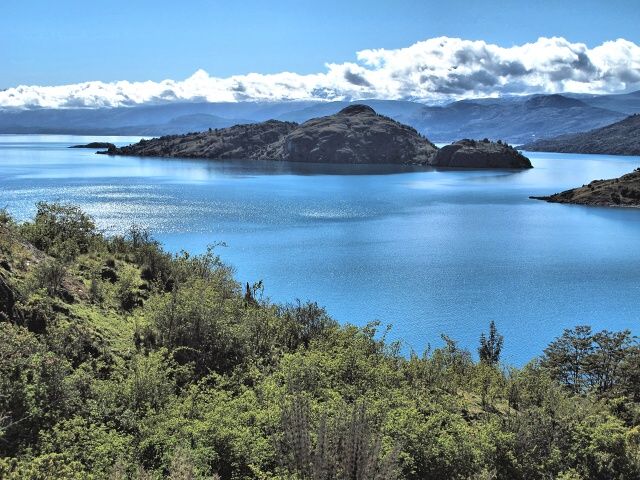
[Near El León] General Carrera Lake (the Argentinian section is called Lago Buenos Aires)
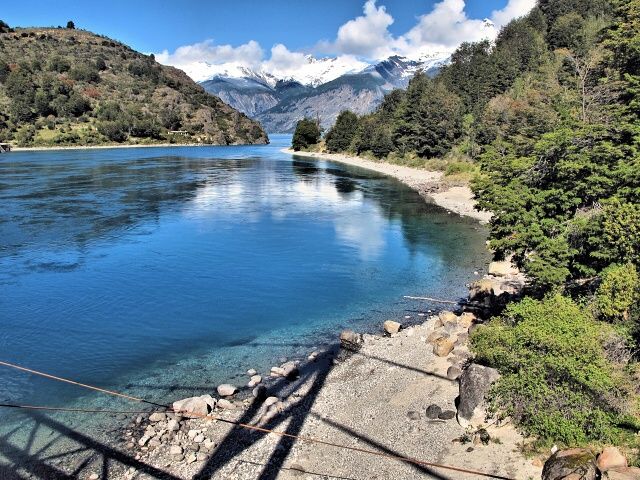
[Near El León] On the bridge over one of the branches of Lago General Carrera

[Negro Lake] A view of Lago General Carrera over Lago Negro; in the middle you can see the Carretera Austral road
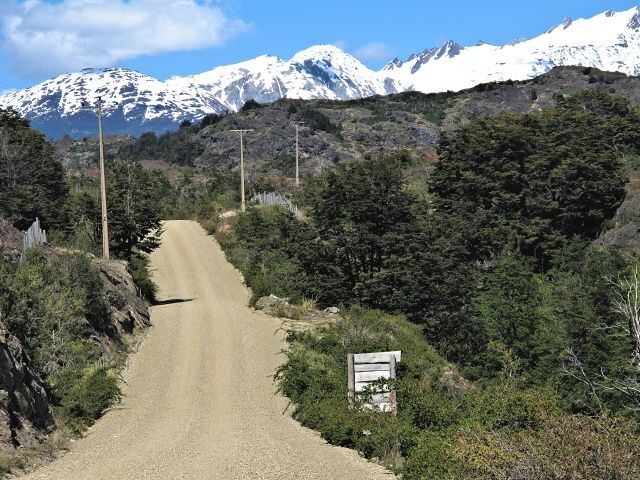
[Negro Lake] Carretera Austral is a challenge not to be resisted
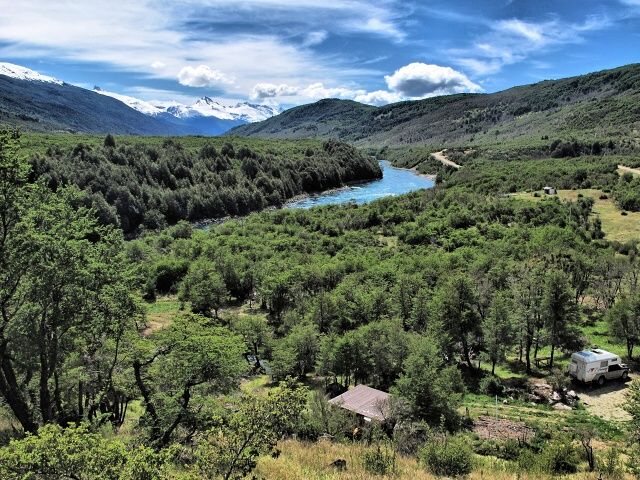
[Near Puerto Bernard] Rio Baker
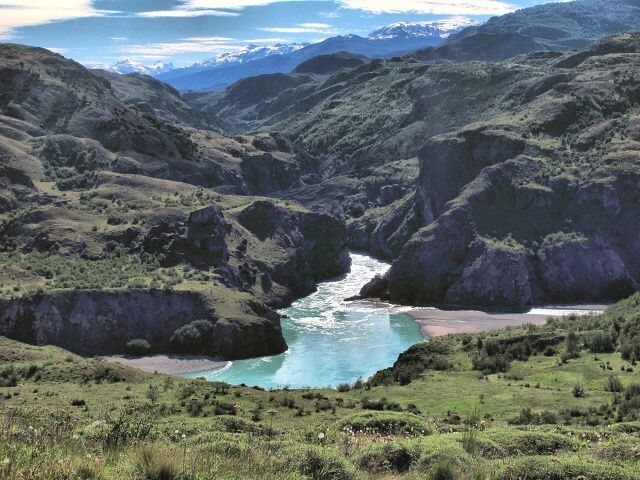
[Near Cochrane] The confluence of two rivers - Baker and Chacabuco
In Cochrane I quickly bought some more tightening tapes and a gas bottle for the cooker and went to search for information on the ferry sailings from Villa O'Higgins. I got the phone number of the manager of the Hielo Sur Shipping Company and called him. In my primitive Spanish I asked whether the boat would be sailing and he answered in the affirmative. However, in the hostel I learned that the Argentinian ferry across Lago Desierto, which normally sailed daily except on Mondays, reportedly had technical problems and would not be renewing its operations before 15th November. But there was a 15-km track around the lake, supposedly unsuitable for cyclists. For a moment, I had my doubts, but it was clear that I would have to go that way and would somehow push the bike through.
Easy Route
After the experience with the road to Cochrane, I expected hard work on the hills, but it was easy. The road was hilly but not steep and it was possible to cycle uphill. Camping, too, was not a problem. The area surrounding the Barrancas River was not fenced off, so I conveniently chose a site for my tent. The next day was similar. At the Tortel and Puerto Yungau crossroads, there was a ferry timetable for the sailing across the Rio Bravo. Off-season, the boat sailed at 10 a.m. and 4 p.m. It was almost 2.30 p.m., the road sign indicated 30 km to Puerto Yungau and so it was clear that, under the present conditions, I would not make it. I ate a snack, filtered some water from the Rio Vagabundo, made a sweet Tang and leisurely cycled towards the harbor. To my surprise, I reached the harbor at 4.20 p.m., which was actually only 17 km from the crossroads. It is interesting that the GPS also stated 30 km and, on the map, the harbor was placed far away from any water (and I had not noticed this at the crossroads). Puerto Yungay is, if you forgive the expression, a backwater without any stores. At the harbor there was only a kiosk, with a lady selling pies. I ate them, the one with nalca was delicious, something like our rhubarb cake. Nalca is a great source of fluid growing along the roads. You just peel off the stem and the succulent flesh contains plenty of pleasantly sour juice. I arranged with the lady that she would bring me some eggs from her home in the morning and prepare breakfast from them for me at 9 a.m. I made a bed in the harbor just above the tide line so that the ocean did not carry me and the tent away. I made a pretty decent bonfire of driftwood. Only the absence of stars in the cloudy sky bothered me. Otherwise it was perfect.
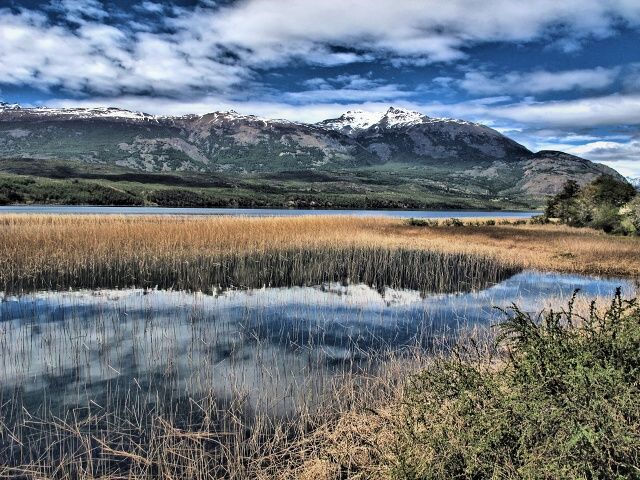
[Esmeralda Lake] The route was easy and interesting with many lakes
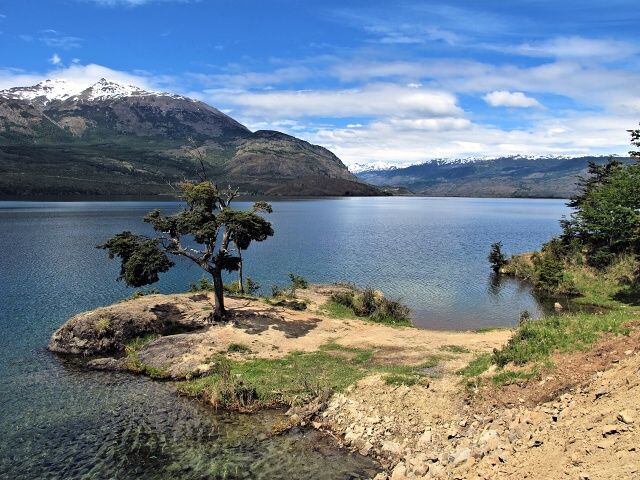
[Esmeralda Lake] A solitary spur with a tree
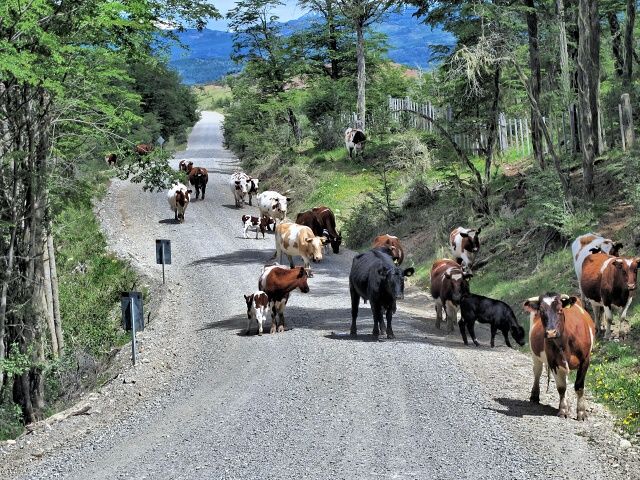
[Esmeralda Lake] A common situation: cattle on the road (and unlike on Czech roads, beasts are not found behind steering wheels)

[Near the intersection of Tortel and Puerto Yungay] Rio Baker
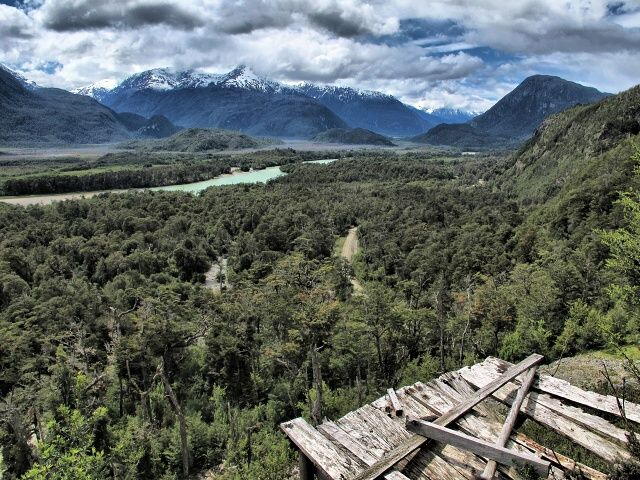
[Intersection of Tortel and Puerto Yungay] Rio Baker and the mountains around

[Near Puerto Yungay] Waterfalls were just next to the road
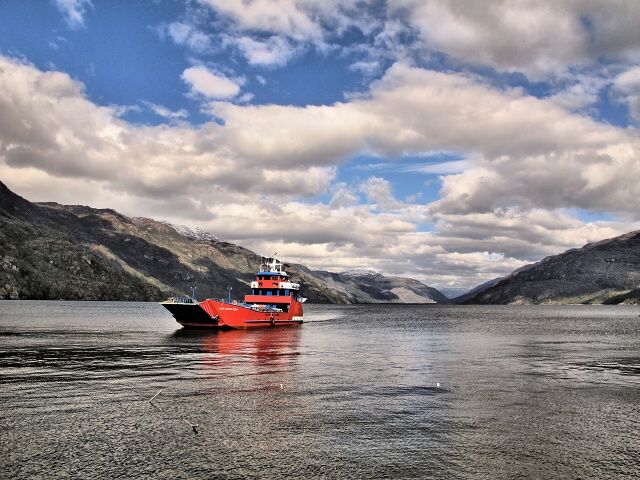
[Puerto Yungay ] A ferry coming from Rio Bravo
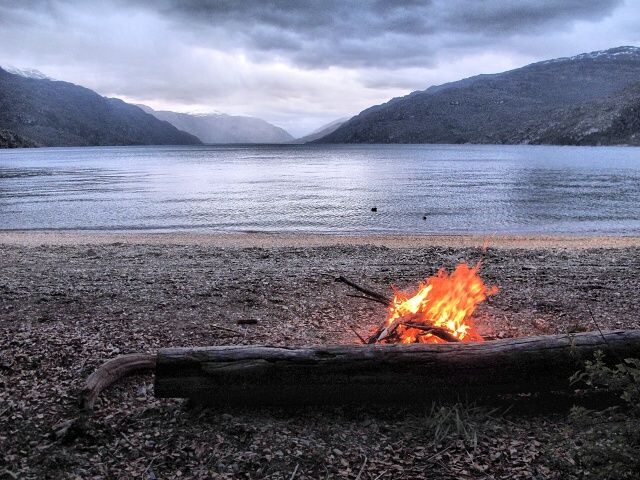
[Puerto Yungay ] I slept over at the seaside and lit a fire for my pleasure
Villa O'Higgins
In the morning, it started to rain again, fortunately just after I had packed up the tent. The ferry was free, because it substituted for the non-existent road. There were also two cars on the ferry with me. Before 11 a.m. I was on the other side of the Rio Bravo with nearly 100 km ahead of me. Due to the steep uphill route, I knew that I would not be reaching the finish that day. It was raining heavily, I was soaked through from the outside and sweating from the inside due to the hard labor up the hills, but otherwise lacked for nothing. It would not be a problem to sleep next to the road, so I was not in a hurry. I had one extra day. A positive feature was the very strong wind which pushed me ahead in the open areas. There were numerous waterfalls along the road, gushing down from the surrounding steep glacier-topped mountains. I love waterfalls, but did not even stop at these. I merely slowed down, admired them and cycled on. I guess the wind helped me to finally reach my destination. After 8 p.m., I entered the village over a broken cattle grid with a treacherous hole in the middle. Before that, the front left pannier rack had also cracked, so I just fixed it with the tapes and decided to repair it the following day.
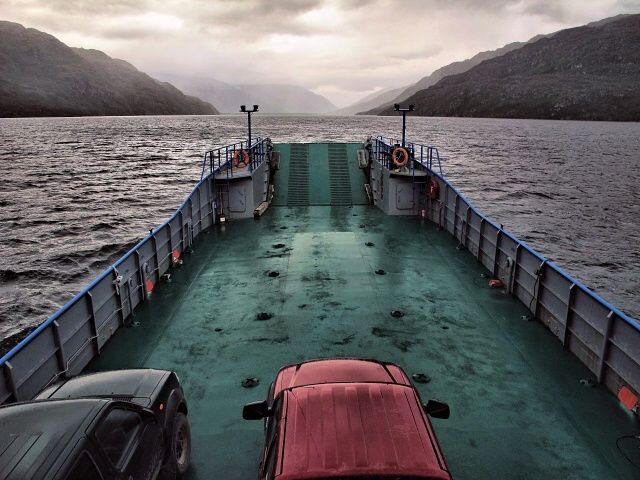
[Puerto Yungay ] A dreary morning on the boat floating towards Rio Bravo

[Near Bravo River] The first half of the journey passed over several saddles
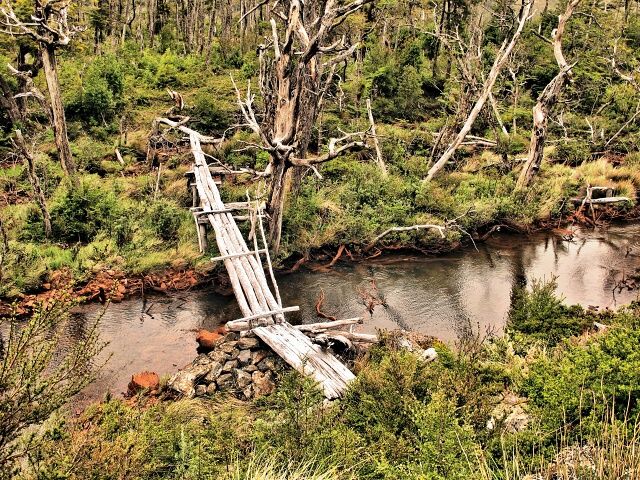
[Near Bravo River] A small wooden bridge
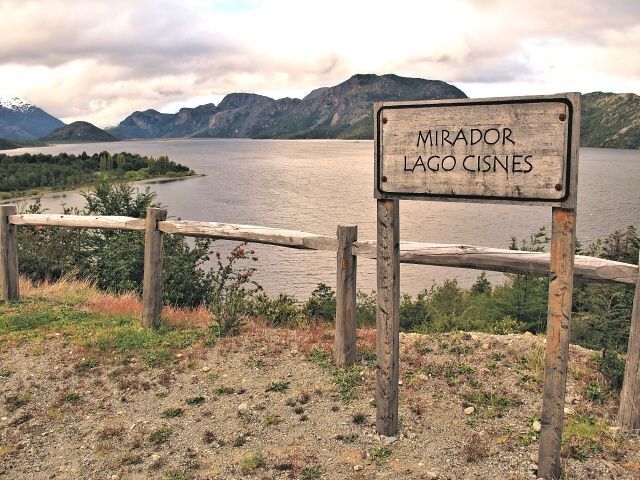
[Near Villa O'Higgins] The Cisnes lake
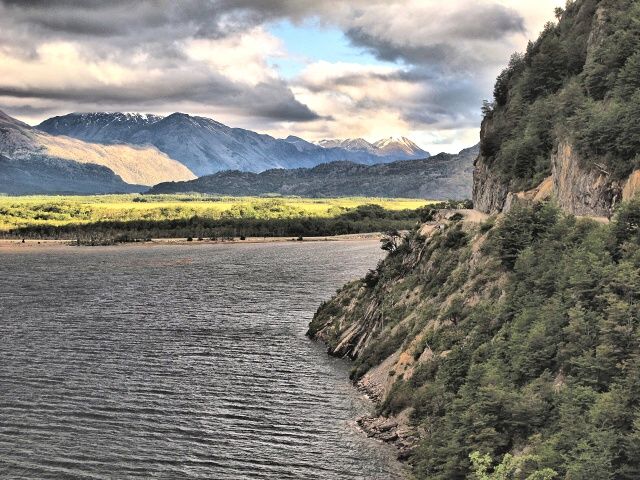
[Near Villa O'Higgins] The road cut into rocks
Villa O'Higgins is a small town, with currently about 500 inhabitants. It was founded in 1966, but more people settled there only after 1999, when the road was extended. Nothing to be seen, only a few stores with food (for which I was thankful) and three restaurants that were not open as it was off-season. In the season, it attracts tourists with the beautiful landscape and especially the southern glacier areas which are also the biggest source of income in that region.
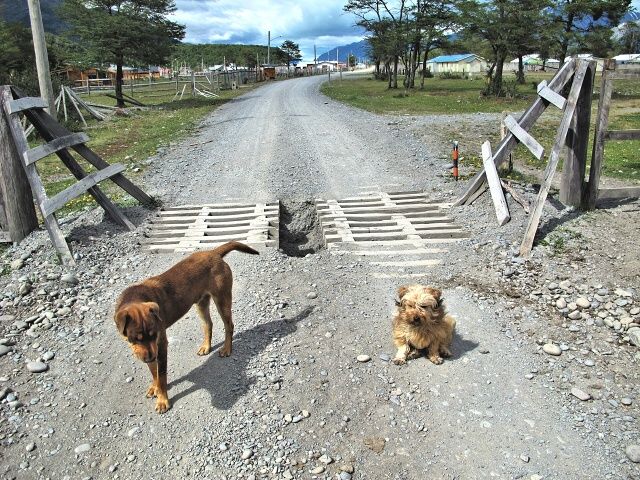
[Villa O'Higgins] The entrance to the last settlement at Carretera Austral with a cyclist trap – a
1-meter deep hole in the middle of the cattle grid
Instant Popularity
When I went to buy beer, I met some Australians from Cochrane who directed me to the hostel and El Mosco campsite. These were the three cyclists about whom the lady in the jetty kiosk had told me. They were all amazed that it had only taken me one day, they had done the same trip in two days. I humbly suggested that it was not that I was so good, but because I had a newly developed bike from the Mongoose company for testing, with a completely new material design of aluminum and wood. They were all utterly astonished, stopped eating, put down their glasses and went out to the front of the hostel. There I showed them the bike with the woodwork, and everyone burst out laughing. Well, we sat chatting in the dining room until 2 a.m. In the morning, the owner asked if we would be less noisy the next night, as he had to sleep upstairs and also an organized group of 15 people would be arriving, so we should not disturb their sleep.
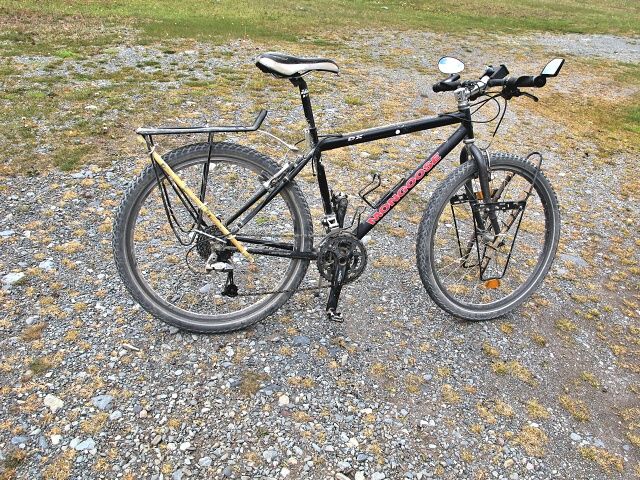
[Villa O'Higgins] Bicycle model “3 WS" – ("3 times Wooden Support") – two in front and one at the back
The next day, I bought a ticket for the boat (about 70 USD), had my clothes washed, fixed the pannier rack and bought food supplies, some of which would have to be kept secret from the Argentinian Customs, or be confiscated. However, the weather forecast was bad. A strong wind was expected on the Saturday, so we could expect to be stuck there until Sunday or longer.
Good News
According to the weather forecast, it seemed that the ship would be sailing on Sunday, 13th November. The entire ensemble, which now included six cyclists and five pedestrians, would be sailing to Candelario Mansilla the following day and subsequently cross and partially push their bikes into Argentina.
By the way, two Italian cyclists, who had arrived at the hostel that day, confirmed to me that, from that year, it was possible to travel to Carretera Austral all-year-round from Puerto Montt. All three ferries were operating between Pto Montt and Chaitén.



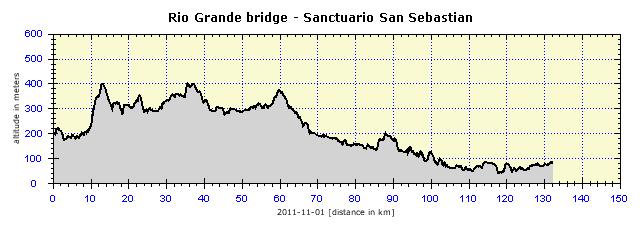
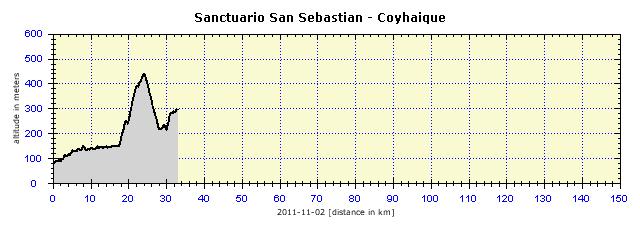
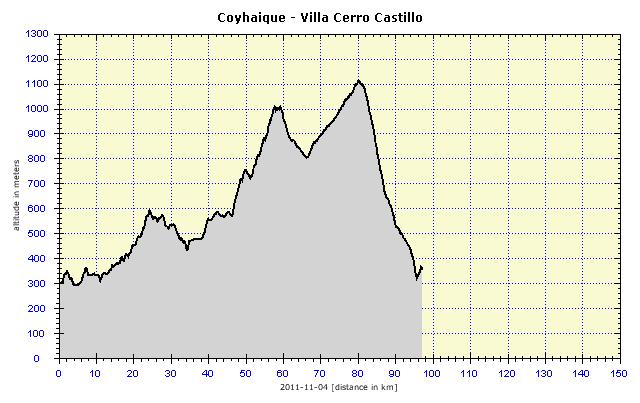
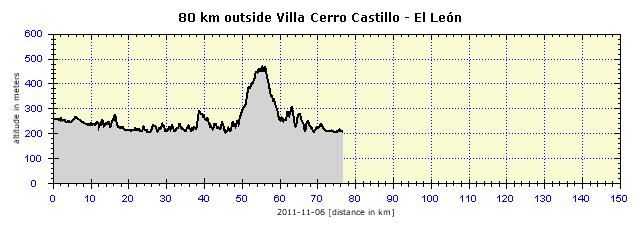
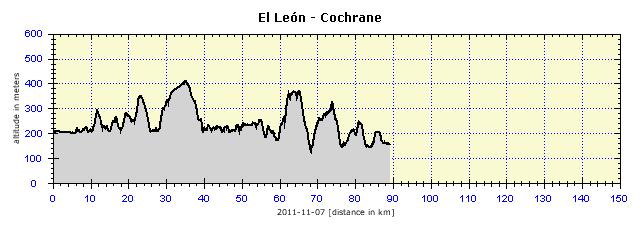
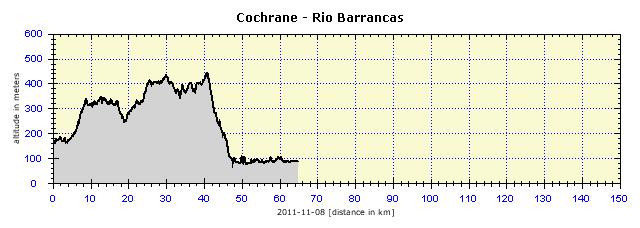
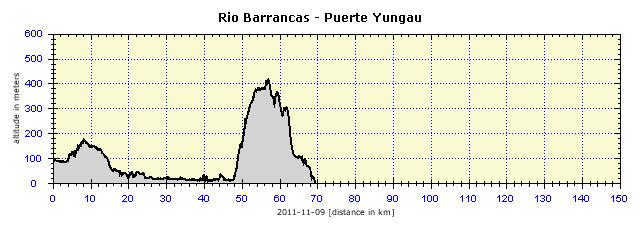
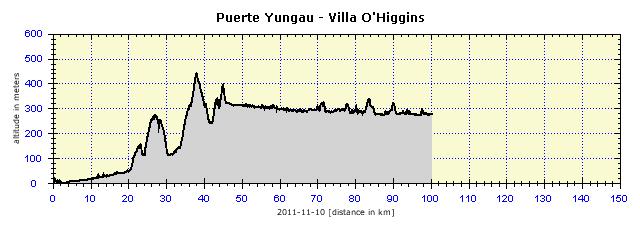
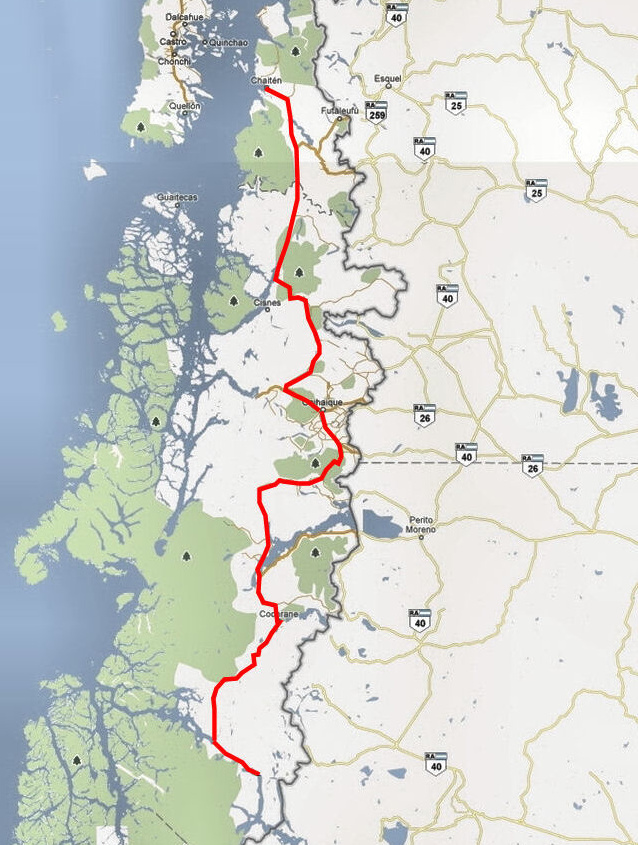
| 






































































